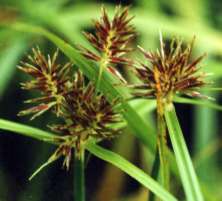Description
Potentially Misidentified Species- At least 14 Cyperus sp.are known from intertidal areas of Chesapeake Bay. Several other introduced species in the watershed include C. difformis (Variable Flatsedge), C. iria (Ricefield Flatsedge), and C. rotundus (Purple Nutsedge) from nontidal wetlands and uplands.
Taxonomy
| Kingdom | Phylum | Class | Order | Family | Genus |
|---|---|---|---|---|---|
| Plantae | Magnoliophyta | Liliopsida | Cyperales | Cyperaceae | Cyperus |
Synonyms
Invasion History
Chesapeake Bay Status
| First Record | Population | Range | Introduction | Residency | Source Region | Native Region | Vectors |
|---|---|---|---|---|---|---|---|
| 1899 | Extinct | Contracting | Introduced | Regular Resident | Europe | Eurasia | Shipping(Dry Ballast) |
History of Spread
Cyperus fuscus (Brown Flatsedge) is native to Eurasia from Greenland and Iceland) south throgh Europe to Mediterranean Africa and northern India (McKenzie et al. 1998). It was first found in North America in 1877 along Revere Beach MA) and was subsequently found in a number of Northeastern seaports and estuaries, including the tidal Connecticut River (Graves et al. 1910) the Delaware River at Philadelphia (Rhoads and Klein 1993), ponds and marshy areas near docks at Canton MD, on Baltimore Harbor, in 1901-1904 (Fessenden 1956; U.S. National Herbarium collections), and in 'wet waste ground near wharves', Washington and Alexandria (Hitchcock and Standley 1919). These locations are consistent with transport in dry ballast. We have no clear recent records of C. fuscus from East Coast estuaries. However, this sedge is established in MO, NE, NV, and CA (McKenzie et al. 1998).
In Chesapeake Bay, Cyperus fuscus was collected in various locations in Washington and Alexandria (Hitchcock and Standley 1919), including 'the Duke St. Sewer'' in Alexandria (U.S. National Herbarium collections). In Virginia, it is known only from Fairfax and Arlington Counties (Harvill et al. 1992). In the Baltimore area, in 1901-1904, C. fuscus was found in ballast piles and bayside ponds in Canton (Fessenden 1956). We have found no recent reports of specimens from Chesapeake Bay and assume that this plant is extinct in the region. Mark Strong, of the U.S. National Museum of Natural History, Botany Department, has not seen this plant in the Chesapeake Bay region (Strong 1995).
References- Fessenden 1956; Graves et al. 1910; Harvill et al. 1992; Hitchcock and Standley 1919; McKenzie et al. 1998; Rhoads and Klein 1993; Strong 1995; U.S. National Herbarium collections
Invasion Comments
Ecology
Environmental Tolerances
| For Survival | For Reproduction | |||
|---|---|---|---|---|
| Minimum | Maximum | Minimum | Maximum | |
| Temperature (ºC) | ||||
| Salinity (‰) | 0.0 | 0.0 | ||
| Oxygen | ||||
| pH | ||||
| Salinity Range | fresh-oligo |
Age and Growth
| Male | Female | |
|---|---|---|
| Minimum Adult Size (mm) | ||
| Typical Adult Size (mm) | ||
| Maximum Adult Size (mm) | ||
| Maximum Longevity (yrs) | ||
| Typical Longevity (yrs |
Reproduction
| Start | Peak | End | |
|---|---|---|---|
| Reproductive Season | |||
| Typical Number of Young Per Reproductive Event |
|||
| Sexuality Mode(s) | |||
| Mode(s) of Asexual Reproduction |
|||
| Fertilization Type(s) | |||
| More than One Reproduction Event per Year |
|||
| Reproductive Startegy | |||
| Egg/Seed Form |
Impacts
Economic Impacts in Chesapeake Bay
Cyperus fuscus (Brown Flatsedge) appears to be extinct in the Chesapeake Bay region, and has no reported economic impacts there.
Economic Impacts Outside of Chesapeake Bay
Cyperus fuscus (Brown Flatsedge) appears to be expanding its range in the midwestern (MO, NE) and western (CA, NV) US and is regarded as potential wetland invader and weed (McKenzie et al. 1998).
References- McKenzie et al. 1998
Ecological Impacts on Chesapeake Native Species
Cyperus fuscus (Brown Flatsedge) appears to be extinct in the Chesapeake Bay region, and has no reported impacts on native biota.
Ecological Impacts on Other Chesapeake Non-Native Species
Cyperus fuscus (Brown Flatsedge) appears to be extinct in the Chesapeake Bay region, and has no reported impacts on exotic biota.
References
Brown, Melvin L.; Brown, Russell G. (1984) Herbaceous Plants of Maryland, , College Park. Pp.Fernald, Merritt L. (1950) Gray's Manual of Botany, In: (Eds.) . , New York. Pp.
Fessenden, G. R. (1956) Extracts from the journal of Charles C. Plitt: Plants of the Baltimore ballast grounds, Wild Flower 32: 44-47
Gleason, Henry A. (1963) The new Britton and Brown illustrated flora of the northeastern United States and adjacent Canada, In: (Eds.) . , New York. Pp.
Gleason, Henry A.; Cronquist, Arthur (1991) Manual of vascular plants of northeastern United States and adjacent Canada, In: (Eds.) . , Bronx, New York. Pp.
Graves, Charles B.; Eames, Edwin H.; Bissel, Charles H.; Andrews, Luman; Harger, Edgar B.; Wetherby, Charles Alfred (1910) Catalogue of the flowering plants and ferns of Connecticut, , Hartford. Pp.
Harvill, A. M.; Bradley, Ted R.; Stevens, Charles E.; Wieboldt, Thomas F.; Ware, Donna M. E.; Ogle, Douglas W.; Ramsey, Gwynn W.; Fleming, Gary P. (1992) Atlas of the Virginia Flora, , Burkeville, VA. Pp.
Hitchcock, A. S.; Standley, P. C. (1919) Flora of the District of Columbia and Vicinity., In: (Eds.) . , Washington, D. C.. Pp.
McKenzie, Paul M.; Jacobs, Brad; Bryson, Charles T.; Tucker, Gordon C.; Carter, Richard (1998) Cyperus fuscus (Cyperaceae), New to Missouri and Nevada, with Comments on its Occurrence in North America, Sida 18: 325-333
1997-2024 USDA PLANTS Database.. Onine databse
Rhoads, Ann Fowler; Klein, William McKinley, Jr. (1993) The Plants of Pennsylvania, , Philadelphia. Pp.
1995 ---missing info----. Conversation
1995 Introduced plants in the Chesapeake Bay region, conversation with Paul Fofonoff.
